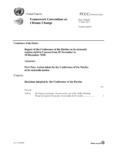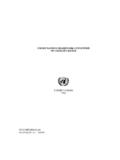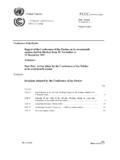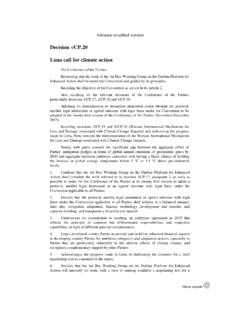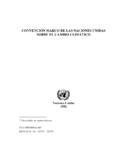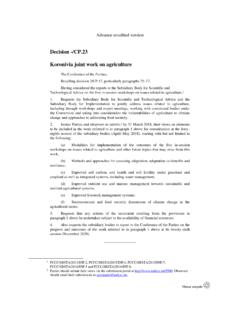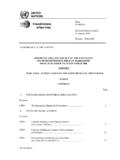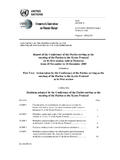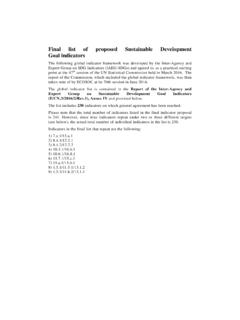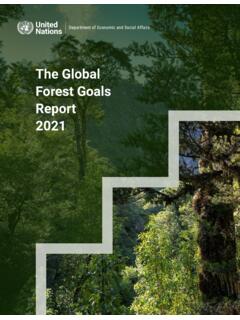Transcription of Livestock production and climate change - UNFCCC
1 World Society for the Protection of Animals Submission to UNFCCC consultation on the role of Livestock in climate change : February 2012. Livestock production and climate change Submission to the UNFCCC Subsidiary Body for Science and Technological Advice (SBSTA) consultation on Livestock and climate change from the World Society for the Protection of Animals The World Society for the Protection of Animals (WSPA) seeks to create a world where animal welfare matters and animal cruelty ends. WSPA has offices in 16 countries worldwide. Our work on the ground is carried out with local partners for greatest effect, and we are active in more than 50 countries. We campaign effectively to combat the world's most intense and large-scale animal welfare issues, bringing about lasting change by: helping people understand the critical importance of good animal welfare encouraging nations to commit to animal-friendly practices building the scientific case for the better treatment of animals encouraging a worldwide movement towards better animal welfare.
2 WSPA submits two papers to the consultation: Livestock production and climate change ; and Livestock production , climate change and disaster management. 1. Summary of recommendations In light of the evidence presented below, the World Society for the Protection of Animals considers that any policy seeking to tackle greenhouse gas (GHG) emissions from agriculture must meet the triple test of being economically viable, ecologically sound and socially acceptable. WSPA considers that a sustainable food production system which delivers environmental protection, reduces GHG emissions and ensures good animal welfare, public health and meat quality is possible. Any mitigation of emissions from Livestock must be based on high animal welfare standards to enhance the potential for reducing emissions.
3 WSPA makes five recommendations for policy and its implementation and asks that these be included in the outcome of the UNFCCC Subsidiary Body for Science and Technological Advice (SBSTA) consultation on Livestock and climate change : 1. Recognise the positive role Livestock and animal welfare can have in achieving sustainable agriculture and incorporate specific and regionally-sensitive policies and measures to ensure that global food production is both humane and sustainable;. 2. Use investment in research and development to promote and support humane, integrated Livestock farming systems to ensure farmers' livelihoods and the climate resiliency of rural communities;. 3. Phase out subsidies and public investment for unsustainable, intensive farming systems while providing support for farmers rearing Livestock humanely and sustainably.
4 4. Recognise the importance of Livestock in economic development and the role farm animals play in helping to lift people out of poverty and build sustainable livelihoods in developing countries;. 5. Recognise and address the challenge of unsustainable demand for farm animal products. 1. World Society for the Protection of Animals Submission to UNFCCC consultation on the role of Livestock in climate change : February 2012. 2. Introduction The world is facing major challenges, from feeding the growing population to tackling severe environmental crises including natural resource degradation and catastrophic climate change . Most studies that address the future direction of the food system suggest that sustainable agriculture and food security must be key objectives of any global or national strategy.
5 But, with just a few exceptions1, they fail to grasp the huge significance of Livestock production and consumption in achieving these goals. When Livestock systems are referred to, the emphasis is often on the sustainable intensification' of industrial systems, which has major implications for the welfare of billions of animals, as well as the environment. This submission examines Livestock production in the context of climate change mitigation and analyses how farming solutions to environmental challenges can be both sustainable and humane. It demonstrates that environmental objectives can be met without jeopardising food security , while rearing animals in humane farming systems. 3. The scope of the challenge Ongoing damage to the environment is seriously affecting the economic sectors that form the basis of our food supply (fisheries, agriculture, freshwater, forestry ) and are a critical source of livelihoods for the poor.
6 Already, 60 per cent of the world's major ecosystems . from soils, water, forests and fisheries on which we depend have been degraded, polluted or used climate change is the planet's biggest threat, affecting land and water availability and crop yields at a time when populations are rising fast, periodically causing food crises3. Globally, there is an urgent need to reduce the greenhouse gas (GHG) emissions that cause climate change by at least 80 per cent in wealthy countries and to protect the biodiversity which underpins food production . 4. How Livestock production affects the environment Measuring the emissions caused by the food supply system is difficult given the complexity and global nature of feed and food supply chains.
7 Lifecycle analysis (LCA) results for GHG. emissions measured by kilogram of output are often lower when output per animal is higher. This can be taken to suggest that intensive animal farming which includes breeding for high yields, permanent indoor housing and concentrate feeding of animals is the best way to reduce Livestock emissions. However, this assessment is far too simplistic. It fails to account for significant elements of the farming system, such as co-products (other products arising from the system of production ). It also often ignores the most disturbing waste in industrial scale animal production systems, for example the killing at birth of offspring considered unsuitable for production , as seen in egg laying chicken production or some high yield dairy systems.
8 Indeed, when taking into account all aspects of dairy production , including their fertility, productive lifespan and beef production from male dairy calves, evidence shows extensive systems have lower GHG emissions (see below). 2. World Society for the Protection of Animals Submission to UNFCCC consultation on the role of Livestock in climate change : February 2012. When impacts are measured per hectare of land used, less intensive and organic methods often have a smaller environmental footprint. This is significant when assessing local impacts, such as biodiversity loss and water or soil pollution. Effects on climate change All food -producing agricultural activities generate GHG emissions, so the question is: how do we feed the growing population while minimising emissions?
9 According to the United Nations Environment Programme, when considering the entire food chain (including deforestation for grazing, forage production , and so on), meat production accounts for 18-25 per cent of the world's GHG Left unchecked, animal production is predicted to account for 70 per cent of the sustainable level of all global GHG. emissions by This level of global consumption poses severe sustainability challenges. Animal farming contributes to GHG emissions through several routes. The most significant are carbon dioxide from land use and its changes (32 per cent), nitrous oxide from manure and slurry (31 per cent) and methane from animal digestion (25 per cent). Why animal welfare matters to climate change As noted above, GHG emissions relate to different elements of Livestock production .
10 The health and productivity of animals and breeding herds (such as cattle and pigs) are an important factor. Many studies confirm that animal health and welfare are integral to environmental sustainability. Breeding for health can create productivity and welfare benefits and result in lower emissions. Robust breeds of animals reared in extensive systems often have longer productive lifetimes and these systems often have lower reliance on fossil fuel and grain inputs. Intensive high input, high output' systems that appear highly efficient at first glance are in fact energy and resource hungry. By focusing on high yields, these systems have unintended consequences, including shortening animals' productive lives and introducing massive waste, such as the breeding of surplus animals that are not seen as economically viable.
